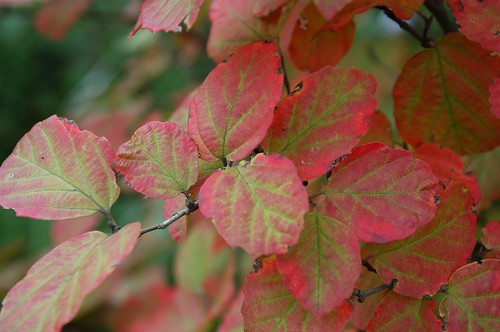
This post is part of the Science Tuesday feature series on the USDA blog. Check back each week as we showcase stories and news from USDA’s rich science and research portfolio.
Like a lot of people, I remember being taught when I was young that the brilliant autumn foliage of deciduous trees was caused by the cold temperatures of autumn frosts. I believed this until I became a horticulturist, studying the intricate system that plants use to prepare for winter’s harsh weather. Where I work, at the U.S. National Arboretum, we grow about 10,000 different kinds of trees and shrubs and have an overwhelming variety of fall color right now.
Daylength (or more correctly, the length of nights) is the real cause of trees’ transition to autumn colors. (Read more here about how longer nights translate into the vibrant color of autumn.)
So what role does frost play in the changing color of autumn leaves? Frost actually ruins vivid fall colors by causing cells in the leaf to rupture and die.
The appearance of fall colors shifts each year due to weather. Heavy cloud cover limits ultraviolet light, so the chlorophyll lasts longer, and leaves stay green longer. High night temperatures cause cells to burn accumulated sugars, so less red and purple pigments are formed and yellow and orange are the predominant colors. Drought stress or a windy interlude cause leaves to drop prematurely.
The ideal conditions are warm, sunny days and cool nights with little wind or drought stress.
At the Arboretum, you can watch this process in action through the course of many months this time of year. Dogwoods begin to turn in late September, and Chinese fringetree ends its show of colors in early December.
Even some of our herbaceous plants have great fall color—most notably the willow amsonia, which you will find near the Capital Columns with ‘Raydon’s Favorite’ asters that are in full bloom right now, also in response to the longer nights of autumn. Willow amsonia blooms in late spring.
There’s a lot to enjoy about the changes autumn brings to the plants around us. Come to the Arboretum and see it. If you’d like to learn more about fall color, attend my lecture on the topic at the U.S. National Arboretum from 1-2 pm on Nov. 5, followed by a fall color tour led by Horticulturist Mariya Navazio.
With sunny weather forecast this week, maples, hickories, and oaks will be at or near peak fall color.

